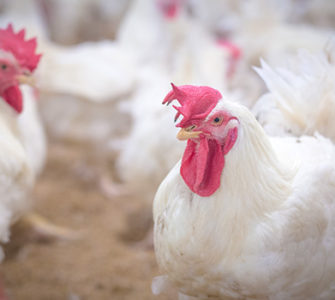Seven misconceptions about IBD in broilers
Infectious bursal disease, or IBD, is one of the most common yet most misunderstood diseases of poultry.
Kalen Cookson, DVM, a poultry veterinarian at Zoetis with extensive experience managing IBD, talked with Poultry Health Today about seven misconceptions about the disease in broilers.
Misconception 1: A high IBD challenge means you have an exotic form.
Generally, it comes down to some deficit in the program itself — either the killed antigens are not sufficiently cross-protective or these antigens, for whatever reason, are not getting adequately expressed and transferred down from the hen to the progeny, Cookson said.
If 20% to 40% of your flocks are becoming infected by 2 weeks of age, it looks exotic, but it’s usually a flaw in the control program, he said.
Misconception 2: Hens transfer the IBD virus to their progeny.
Unlike reovirus, there’s no vertical transmission of IBDV from the hen to the progeny, Cookson said. But there should be, hopefully, a significant transfer of maternal antibodies from the breeder to its progeny. And that is really the backbone of the protection that the broiler is going to be armed with against a field challenge.
Misconception 3: IBD variants are difficult to identify.
“Today we rely a lot on molecular typing, specifically sequencing analysis,” Cookson said. “We have a pretty good idea when we get a sequence on a virus how homologous it is to some of our past variants that have now been well characterized.
“About 20 years ago, we found a variant virus that seemed to crash the party on maternal antibodies, known as the AL2 virus. We did a survey a couple years ago across the US, and we found that virus has really become the dominant type in US broilers. So, when people talk about having a high IBD virus challenge, most of the viruses are not that different from the AL2 virus.”
Misconception 4: All IBD vaccines function the same way.
On the broiler side, there are three types of IBD vaccines, and they each serve a different mechanism of action, Cookson said. There are conventional modified-live vaccines, recombinant vaccines (HVT-IBD) vaccines and immune-complex vaccines, which are a combination of antibodies specific to IBD virus, with a modified-live vaccine.
Modified-live vaccines are used in the hatchery, tend to be mild and are limited in what they will achieve in immunity, but they can help delay early infections.
Immune-complex vaccines block out early infections capably, and they start to replicate between 2 and 4 weeks of age, depending on maternal antibodies. These vaccines bridge the gap between the modified-live and recombinant vaccines by directly competing with field viruses infecting birds prior to 3 weeks of age.
Recombinant vaccines are most effective when there is a solid maternal immunity program that can prevent infections out to 3 weeks of age –- that’s when the recombinant vaccines really start to hit their stride, Cookson noted.
Misconception 5: Either a recombinant or modified-live IBD vaccine can be used dependably as a priming vaccine.
Historically, breeder pullets were primed with strong conventional live vaccines between 5 and 6 weeks of age. That stimulated immunity to IBD virus, and the birds responded better to the killed vaccine they received between 10 and 20 weeks of age, he said.
More recently, people are adding a recombinant vaccine given in the hatchery. It protects the pullet from the effects of IBD virus but should not be a replacement for the strong live vaccine. People should always use a live prime, Cookson said.
Misconception 6: ‘No antibiotics ever’ programs have no impact on IBD- management strategies.
Eliminating antibiotics puts pressure on everything, and controlling early challenges from IBD virus and reovirus that affect the immune system become even more crucial, he said. It’s harder to protect the immune system when “tools” are taken away, he noted.
Misconception 7: A high IBD challenge requires novel management strategies.
It really comes down to something fundamental about the program that is not quite where it needs to be. Sometimes it comes down to inadequate priming of the breeder flocks or poor application of the killed vaccines. Sometimes the antigenic diversity of the commercial vaccine program can be improved, Cookson reiterated.
Editor’s note: This video interview, podcast and news article were developed independently by the editors of Poultry Health Today. They are presented here solely for their news value. The opinions and recommendations presented are not necessarily shared by the editors of Poultry Health Today or the interviewee’s employer.
Posted on March 30, 2018

















